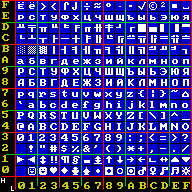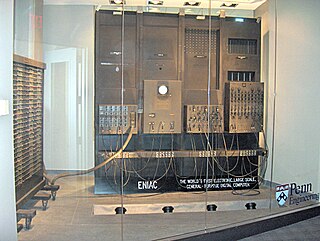
In computing and electronic systems, binary-coded decimal (BCD) is a class of binary encodings of decimal numbers where each decimal digit is represented by a fixed number of bits, usually four or eight. Special bit patterns are sometimes used for a sign or for other indications.

In computing, floating-point arithmetic (FP) is arithmetic using formulaic representation of real numbers as an approximation so as to support a trade-off between range and precision. For this reason, floating-point computation is often found in systems which include very small and very large real numbers, which require fast processing times. A number is, in general, represented approximately to a fixed number of significant digits and scaled using an exponent in some fixed base; the base for the scaling is normally two, ten, or sixteen. A number that can be represented exactly is of the following form:

In mathematics and computing, hexadecimal is a positional numeral system with a radix, or base, of 16. It uses sixteen distinct symbols, most often the symbols "0"–"9" to represent values zero to nine, and "A"–"F" to represent values ten to fifteen.
In computer science, an integer is a datum of integral data type, a data type that represents some range of mathematical integers. Integral data types may be of different sizes and may or may not be allowed to contain negative values. Integers are commonly represented in a computer as a group of binary digits (bits). The size of the grouping varies so the set of integer sizes available varies between different types of computers. Computer hardware, including virtual machines, nearly always provide a way to represent a processor register or memory address as an integer.

In computing, a nibble (occasionally nybble or nyble to match the spelling of byte) is a four-bit aggregation, or half an octet. It is also known as half-byte or tetrade. In a networking or telecommunication context, the nibble is often called a semi-octet, quadbit, or quartet. A nibble has sixteen (24) possible values. A nibble can be represented by a single hexadecimal digit and called a hex digit.

The octal numeral system, or oct for short, is the base-8 number system, and uses the digits 0 to 7. Octal numerals can be made from binary numerals by grouping consecutive binary digits into groups of three. For example, the binary representation for decimal 74 is 1001010. Two zeroes can be added at the left: (00)1 001 010, corresponding the octal digits 1 1 2, yielding the octal representation 112.
Endianness is the sequential order in which bytes are arranged into larger numerical values when stored in memory or when transmitted over digital links. Endianness is of interest in computer science because two conflicting and incompatible formats are in common use: words may be represented in big-endian or little-endian format, depending on whether bits or bytes or other components are ordered from the big end or the little end.

In mathematics and computing, Fibonacci coding is a universal code which encodes positive integers into binary code words. It is one example of representations of integers based on Fibonacci numbers. Each code word ends with "11" and contains no other instances of "11" before the end.
A computer number format is the internal representation of numeric values in digital computer and calculator hardware and software. Normally, numeric values are stored as groupings of bits, named for the number of bits that compose them. The encoding between numerical values and bit patterns is chosen for convenience of the operation of the computer; the bit format used by the computer's instruction set generally requires conversion for external use such as printing and display. Different types of processors may have different internal representations of numerical values. Different conventions are used for integer and real numbers. Most calculations are carried out with number formats that fit into a processor register, but some software systems allow representation of arbitrarily large numbers using multiple words of memory.

The ternary numeral system has three as its base. Analogous to a bit, a ternary digit is a trit. One trit is equivalent to log2 3 bits of information.

An International Standard Serial Number (ISSN) is an eight-digit serial number used to uniquely identify a serial publication. The ISSN is especially helpful in distinguishing between serials with the same title. ISSN are used in ordering, cataloging, interlibrary loans, and other practices in connection with serial literature.
Excess-3, 3-excess or 10-excess-3 binary code or Stibitz code is a self-complementary binary-coded decimal (BCD) code and numeral system. It is a biased representation. Excess-3 code was used on some older computers as well as in cash registers and hand-held portable electronic calculators of the 1970s, among other uses.
IBM System/360 computers, and subsequent machines based on that architecture (mainframes), support a hexadecimal floating-point format (HFP).

The Electronic Product Code (EPC) is designed as a universal identifier that provides a unique identity for every physical object anywhere in the world, for all time. The EPC structure is defined in the EPCglobal Tag Data Standard, which is an open standard freely available for download from the website of EPCglobal, Inc.. The canonical representation of an EPC is a URI, namely the 'pure-identity URI' representation that is intended for use when referring to a specific physical object in communications about EPCs among information systems and business application software. The EPCglobal Tag Data Standard also defines additional representations of an EPC identifier, such as the tag-encoding URI format and a compact binary format suitable for storing an EPC identifier efficiently within RFID tags. The EPCglobal Tag Data Standard defines the structure of the URI syntax and binary format, as well as the encoding and decoding rules to allow conversion between these representations. The EPC is designed as a flexible framework that can support many existing coding schemes, including many coding schemes currently in use with barcode technology. EPC identifiers currently support 7 identification keys from the GS1 system of identifiers, as well as a General Identifier and EPC identifiers that can be used for encoding supplies to the US Department of Defense.

ISO 6346 is an international standard covering the coding, identification and marking of intermodal (shipping) containers used within containerized intermodal freight transport. The standard establishes a visual identification system for every container that includes a unique serial number, the owner, a country code, a size, type and equipment category as well as any operational marks. The standard is managed by the International Container Bureau (BIC).
Electronic serial numbers (ESNs) were created by the U.S. Federal Communications Commission (FCC) to uniquely identify mobile devices, from the days of AMPS in the United States starting in the early 1980s. The administrative role was taken over by the Telecommunications Industry Association in 1997 and is still maintained by them. ESNs are currently mainly used with CDMA phones, compared to International Mobile Equipment Identity (IMEI) numbers used by all GSM phones.
BCD, also called alphanumeric BCD, alphameric BCD, BCD Interchange Code, or BCDIC, is a family of representations of numerals, uppercase Latin letters, and some special and control characters as six-bit character codes.
The MSP432 is a mixed-signal microcontroller family from Texas Instruments. It is based on a 32-bit ARM Cortex-M4F CPU, and extends their 16-bit MSP430 line, with a larger address space for code and data, and faster integer and floating point calculation than the MSP430. Like the MSP430, it has a number of built-in peripheral devices, and is designed for low power requirements.







